
A joint study by Econsultancy and RedEye found that only 28% of companies are satisfied with their conversion rates, while 37% reported they’re either quite dissatisfied or very dissatisfied.
There could be many reasons for this lack of satisfaction. But from what I’ve seen with my past CRO projects, one major cause is marketers frequently missing out on some optimization opportunities that would improve their B2B conversion rates.
I don’t blame them, of course. There’s a lot that goes into B2B conversion optimization, and it’s easy to miss a few things. In my experience, though, these are three conversion optimization practices that marketers definitely shouldn’t be overlooking:
1. Simplify Customer Experiences
The most straightforward step can also be the most overlooked. A lot of B2B companies tend to overcomplicate their sales funnels and customer experiences.
And that doesn’t do anything to help their conversions.
Instead, they end up losing potential conversions because some of their leads get tired of going through the whole process. They end up leaving the website with an abandoned purchase or signup form. (According to the Baymard Insitute, 26% of customers report abandoning their purchase because the checkout process was too long or complicated.)
You need to minimize the steps required for people to convert. With this in mind, reconsider your sales funnel stages and look for opportunities to simplify the whole process:
- Is there any step you can remove from your sales funnel?
- How many stages do potential buyers have to go through to be considered a conversion?
- Are all of those stages absolutely necessary?
Simplify Your Design
Similarly, you should simplify your customer experiences by keeping your website design and layout simple. The main focus should be on what’s most important—your compelling copy and actionable CTA.
Your site design can deliver better conversions because, according to BigCommerce, it’s the critical factor influencing the buying decisions of 76% of B2B buyers.
Remove any unnecessary design elements that could be distracting your visitors. Do you really need to highlight your company events on your homepage? Or what about that low-quality image that takes over the entire screen?
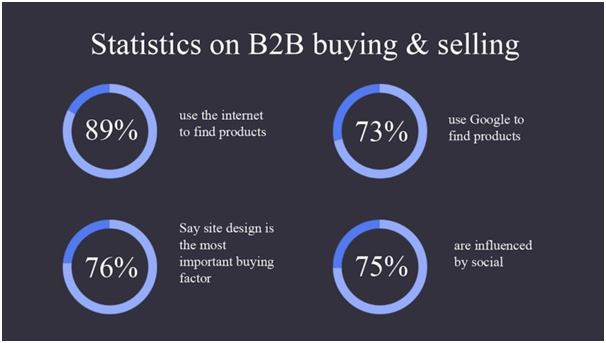
Simplify Your Forms
In this same way, you should also review your signup forms and sign-in pages to see what you can remove or improve. Perhaps you don’t really need to ask for their company address unless you’re delivering a physical product. Or you could start by giving them a one-click sign-in option where they sign in using their social media accounts.
For instance, Venture Harbour made three simple tweaks to their homepage design. They simplified the hero section of the page by replacing the CTAs and buttons with a simple message to relay their key selling point. They improved their forms by switching to intuitive multi-step forms to capture customer information without losing their interest:
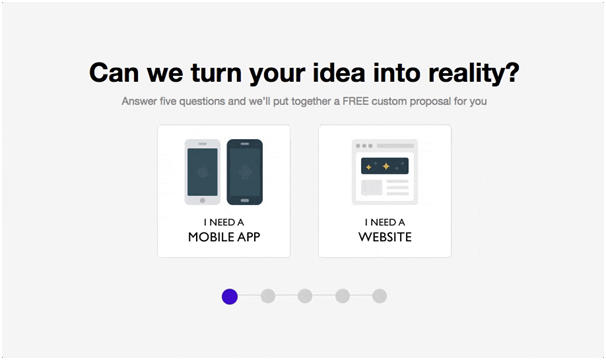
And, instead of selling their services through their hero section, Venture Harbour also opted to showcase compelling copy to highlight how they have helped other businesses. Instead of making baseless claims, they showed proof of the results they can deliver. Together, these three tweaks increased their conversion rate by 500%.
2. Promote Your Content More Strategically
Some B2B companies go all out when promoting their content. They share it everywhere and send notifications about every new piece of content to every subscriber.
While this blast of content may seem like a good idea if you want people to consume your content, it may not necessarily boost conversions. It could even end up annoying people if it isn’t relevant to them.
I recommend taking a more strategic approach to distributing your content. This is very easy to overlook when you’re focused on other aspects of your B2B content marketing strategy, but it can help you plan how to promote your content to specific leads and customers depending on which segment they belong to.
This means you will be showing them more relevant content that is also more likely to guide them through the sales funnel. You could promote your beginner’s guides and 101s to new leads, for example. Or you could send case studies and testimonials to leads that are further down the funnel.
You can start out simple with curated newsletters customized for different segments. Sort your recipients into different segments based on where they are in the funnel and perhaps other factors like department, job role, etc.. Then you can curate some of your best content that will be suitable for each segment rather than hitting everyone with every piece of content.
You can use platforms like FeedOtter to simplify this process. It lets you add content from different sources and easily re-organize them with a drag-and-drop feature. You can even add a personalized greeting and intro to these newsletters for an even bigger impact. Check it out:
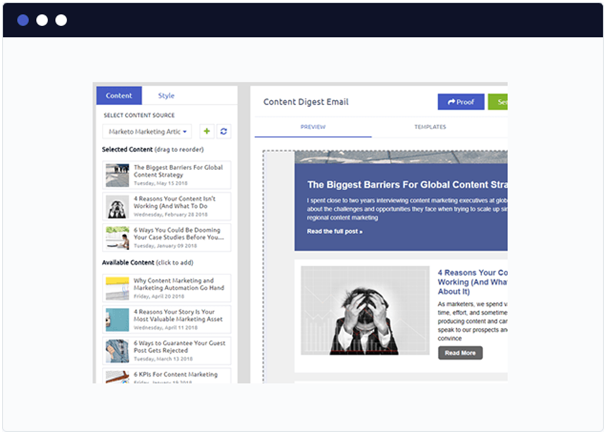
Use Retargeting to Promote Content
I’d also recommend using Facebook Pixels to retarget people who have shown interest in your business before and have a strong chance of converting at some point.
Retarget them with ads promoting content relevant to what they have viewed before. For instance, you could pay to promote an ebook on email marketing. But you would only target people who have read your blog posts on similar topics or viewed your product feature page on email marketing.
There’s plenty of proof this works, including this case study from Facebook Business. Hawke Media executed a strategic content promotion plan, using long-form content to raise awareness in the first stage. They then created ads to target a Custom Audience and Lookalike Audiences according to their email and client list, CRM leads, and traffic. Finally, they used their engagement data to retarget the most relevant audiences with more tailored ads:
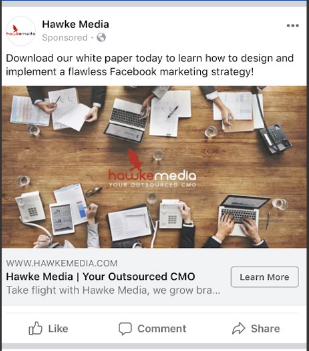
As a result of this comprehensive content promotion strategy, the agency saw a five times increase in blog readership within a year. They also had a 4X return on ad spend, while reducing their cost per lead by 78%.
3. Combine PPC and SEO
This is where a lot of businesses—especially emerging ones—struggle. PPC and SEO each have their unique benefits and drawbacks, so it’s difficult to choose which one to focus on. Which will be more effective to optimize B2B conversion rates?
SEO helps you bring in more organic traffic and delivers long-term results at minimal cost, theoretically. But, at the same time, its impact is slow. You could spend months and hundreds of dollars on content production before you start seeing any results.
PPC, on the other hand, brings in immediate results as it enables precise targeting. But since you get charged for every click, these campaigns tend to be more expensive, even if they do improve conversions.
PPC campaigns may seem like the logical option for conversion optimization. But from how I see it, this isn’t an “either/or” situation.
You don’t have to choose between SEO and PPC. Use them together to deliver better results and improve B2B conversion rates. I suggest using your SEO keyword data to optimize the performance of your PPC campaigns, and vice versa.
Use SEO with your PPC…
Are there any long-tail keywords that have been converting visitors organically? If they’re driving organic conversions, clearly it means they are helping you attract a relevant and interested audience. Giving them a little leverage with PPC campaigns could drive even more conversions.
You can even take this up a notch. There may be some keywords for which you’re ranking organically even when you haven’t made any effort to target them. This means that the keywords are clearly working for you since they are delivering results even without effort.
You can use tools like Pro Rank Tracker to discover keywords for which you’re already ranking organically but are unaware of. You just need to enter your URL in the search bar, and it will give you a complete report of all of the keywords for which your website is ranking. This will include a section of keywords for which you are ranking but aren’t currently tracking. Here’s an example of what this looks like:
…and PPC with your SEO
Similarly, you should monitor the high-performing keywords in your PPC campaigns. This will help you identify the search terms that people typically use when they click on your ads and understand user intent in the process. So put together these top-converting keywords and use them to optimize your organic content.
You can take your approach even further by using PPC to target organic keywords that get a lot of searches but are too competitive to rank for organically. With highly competitive keywords, it will take you months and a lot of effort to organically rank for them on the first page of Google SERPs. So boost your efforts by targeting these keywords in your PPC campaigns, which will get you quick and effective results.
For instance, Zoho isn’t ranking yet on the first page of Google results for the keyword “A/B testing tool” since it’s quite generic and likely to be very competitive. But if you look at the screenshot below, Zoho does shows at the top of the page because they’re targeting the keyword with a PPC campaign. Zoho has paid to surpass the organic results for their top competition such as Optimizely and VWO:
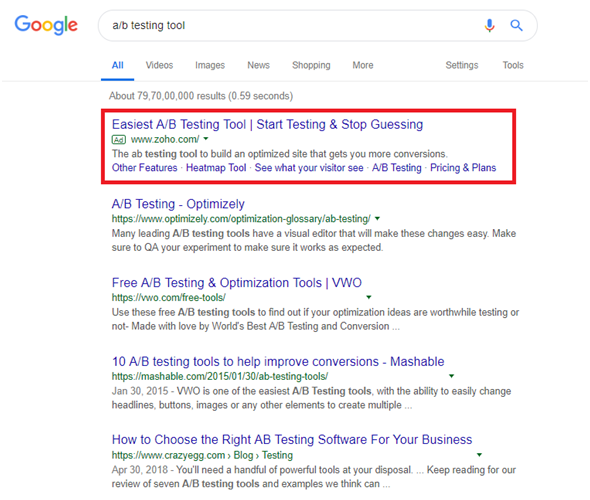
How Do You Improve Your B2B Conversion Rates?
These are some of the best B2B conversion optimization practices that you might be overlooking, especially if you’re just starting out.
But if you haven’t overlooked these suggestions, my final piece of advice is that you should keep looking for new opportunities to optimize your approach for better B2B conversion rates. It’s an ongoing process that you revisit more than once, and chances are there are any other improvements you could be making.
Got any questions (or doubts) about these practices? Let me know in the comments below.
from Unbounce http://bit.ly/2Ilcno8




No comments:
Post a Comment